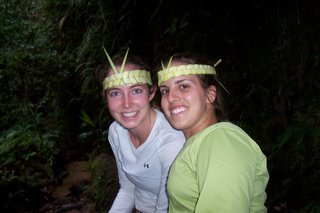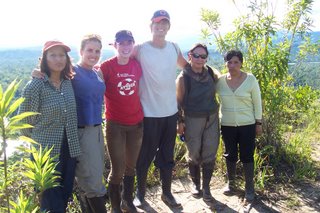Amazon Jungle

It doesn’t get much better than this. The last two weeks were introductions into two other worlds that I really didn’t know much about. Before going to the Amazon jungle for a week, I spent some time visiting different potential volunteering sites, and I was touched by what I saw. I first went to a shelter for adolescent mothers called Talita Kumi, a refuge that many Rotary scholars have visited. It was a humble building that is in great need of repair and finances, and the couple that runs the shelter couldn’t have been nicer. They took me on a tour of the home, and I noticed in their kitchen that they didn’t even have enough food to last them through the week. They aren’t financed by the government (laugh), and provide this refuge for serious circumstances (for young women) with their own money. They teach them how to make chocolates and traditional foods so that they can sell their goods on the street to provide for their children. The other place I visited was called “Enseñame a pescar”, which means Teach Me to Fish. It is essentially an after school program for truly needy children. I entered a class of 30 children of varying ages, and let me tell you, I didn’t know how poorly I understood and spoke Spanish before meeting them. They laughed at me so much I couldn’t help but be put in my place. It comes to find out that I was the first visitor they have ever had at the school, and I was the first North American that many of them have ever met. They asked some of the most endearing questions- What color is the sky? Do you have cows? Does it snow there? Can you salsa dance? Do you eat a lot of oranges in Florida? Do you have Superman cartoons there? How far did you go in school? Why do you want to be in Quito? Can you speak English? They also sang songs they had learned in class, and of course they wanted me to sing and dance with them, so what’s a girl to do? I realized though that choosing a volunteer activity here is going to be harder than I thought. There is just so much need all around the city that I feel like I’ll be neglecting a worthy cause when I choose to spend my time in another.
Before going to the jungle I also had quite a few conversations with my professors about race issues in Ecuador. I’ve noticed that people often use the “vos” form of speaking, and it turns out that people sometimes use this very informal tone to address people who are of more indigenous descent because it’s insulting. The color of skin here is far more important than I had anticipated. Practically the entire population is mestizo, but the visible amount of indigenous blood that people have differentiates them. People often judge others simply based off their last name. If the name is more indigenous sounding, the person is assumed to be of a lower class. My professors agreed that there is more racism toward the indigenous here than against the Afro-Ecuadorain population. I find this interesting because it seems that people are prouder of lighter, Spanish skin, which goes to say that they value the physical traits of their colonizers. Food for thought.

Speaking of thought, I had a lot of time to think this past week in my adventure in the Amazon. I still cannot believe that Ecuador is home to such a variety of landscapes. The Amazon seemed like it was worlds away from civilization, but it was just a five hour bus ride away from Quito. I went with three other students from the Academia de Español and two of the professors. We first went to a lodge called Shangrila, which was an apt name because I fell in love with that place. There was a whole loft of hammocks! My paradise. We had a really knowledgeable guide, and he taught us about the medicinal uses for many of the plants we saw. The jungle reminded me a lot of the Costa Rican rainforest, but we didn’t see any monkeys (or anacondas for that matter, thank goodness). We went hiking, tubing, and canyoning. I had never been canyoning before, and the whole time I was thinking that this activity would never fly in America. It was quite dangerous, and I wouldn’t believe we were all hoisting ourselves up crevices of canyons that had no visible bottom. The rain made it even more interesting because flash floods can apparently occur. We were also able to walk to an indigenous community that was near. The people spoke only Quichua, the most popular indigenous language. Our tour guide was bilingual in both Spanish and Quichua, as are many people in Ecuador (only Spanish is taught in the schools). The town had only about 80 inhabitants, and the “mayor”, Monica, prepared a traditional drink made of mulled yucca root called “chi cha”. Indigenous women used to chew the root and then spit out the root into a bowl. This was stirred and served! Today it isn’t made with saliva (thank goodness), and I didn’t like it, but it’s very high in calcium, and very poor communities can survive off of only two bowls of this drink a day. Yucca is ubiquitous, and I’m beginning to like it more. After Shangrila, we went to a more rustic site without electricity called Amarongachi. I liked it equally as well because it was perched right on the Napo river, and we woke to birds, chickens, and the owner’s 10, that’s right, 10, children. We went on awesome excursions. We climbed waterfalls and swam in a lagoon. The best part was having a local guide who has lived on the land his entire life. We were able to be a part of their family for three days and play cards (a popular game called “cuarenta”) by candlelight. I was sad to go because I love nature so much, but Emily and I were off to Baños for her last weekend in Ecuador. We got a hostal for $6 a night (breakfast included), and we were quite proud of this conquest. We kind of missed the boat in Baños because we thought there would be a lot of thermal baths. Wrong. Instead, we went biking and seemed to get lost even though there was really only one road. Oh silly Lauren and Emily with their map. We saw some great waterfalls and went to see the Pailon del Diablo, an amazing waterfall that’s the convergence point of two main rivers. After our nine days in nature that re-inspired us, it was time to head back to good ol’ Quito. Next are Thanksgiving preparations!!! Emily and I have planned a menu, but we haven’t tried shopping yet. I have a feeling we won’t be able to find a few important things, so it might me a more Ecuadorian Thanksgiving than we think. Happy Thanksgiving, everyone. It is by far my favorite holiday, so I will be missing my cranberry sauce, family, and famous gratitude circle. I’ll be there in thought. Wear your Turkey pants and eat some extra in my honor!

0 Comments:
Post a Comment
<< Home